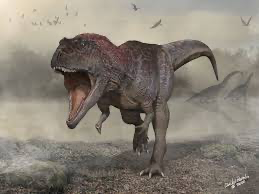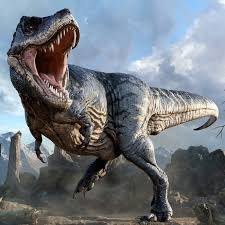Dinosaurs are a diverse group of extinct animals that for 160 million years were the dominant vertebrates on the surface of the globe, specifically from the late Tertiary period (about 230 million years ago) until the end of the Cretaceous period (about 65.5 million years ago). Most species and families of dinosaurs became extinct during the Cretaceous-Paleogene extinction event, and scientists believed for a long time that they did not leave any lineage behind them, but that assumption was proven wrong, as researchers later discovered that birds are the closest relatives of dinosaurs remaining in the current era, and that Through the evidence that appeared linking the two taxa, it was found that all birds today are descended from a common ancestor that evolved from theropod dinosaurs during the Jurassic period. Also, most modern classifications place birds as a surviving group of dinosaurs.
Dinosaurs are one of the most diverse groups of the animal kingdom. Its descendants are birds, the most diverse vertebrates on the face of the earth, as there are more than 9,000 species.[4] Ancient biologists were able to identify more than 500 species [5] and 1,000 different types of non-avian dinosaurs,[6] and today different forms of dinosaurs can be found on all continents of the world, whether they are living represented by birds, or dead ones defined by its inducers. [7] A number of dinosaurs were herbivores and others were carnivores, and some types of them walked on their hind legs, while other types walked on four legs, and some of them were able to move using both methods. Many non-avian dinosaurs developed external extensions of their skeleton that formed a body shield, a bony collar, or horns, and some species have achieved international fame for their strange external shape, as scientists imagine. Bird dinosaurs have dominated the atmosphere of the globe since the extinction of the winged reptiles, which were considered their main competition and the main reason that inhibited their evolution. Dinosaurs are famous for the size of some huge species, which generates an idea among the public that all these animals were giants, but in reality most dinosaurs were human-sized or even smaller. It is known that most species of dinosaurs built nests in which to lay their eggs and incubate them until hatching.
Dinosaur skeletons displayed in museums around the world have become important tourist attractions, since the first dinosaur fossils were discovered in the early nineteenth century, and these animals have become a symbol of the global and local culture of some countries. Dinosaurs have been depicted in many novels and films that have achieved great success and a huge sales rate, such as the “Jurassic Park” series. Any new discovery of great importance is covered by various media and presented to the public interested in these matters.
According to the phylogenetic classification, dinosaurs are usually defined as the group that includes “the trilobites, modern birds, plus their closest ancestors, and all their descendants”.[30] Some have suggested that dinosaurs should be defined according to their degree of kinship to the closest common ancestor of the great dinosaur Megalosaurus and the sauropod Iguanodon, since these are two of the three species that Richard Owen stipulated when he first defined dinosaurs.[31] The two definitions result in the same group of animals defined as dinosaurs, including: theropods, or two-legged carnivores; long-necked or sauropods, which are four-legged herbivores; moltosaurids or ankylosauria, which are herbivores, armored quadrupeds (crocodile-like); hooded lizards or stegosauria, which are four-legged herbivores with bony plates on their backs; Horned lizards or ceratopsians, which are four-legged herbivores with horns and fringes, ornithosaurus or ornithopods, which are two-legged or four-legged herbivores, including the “lap-beak”. These definitions were written to respond to scientific understandings about dinosaurs that predate the modern use of phylogeny. The continuity of meaning is intended to prevent any confusion as to the meaning of the term “dinosaur”.
There is almost universal consensus among paleontologists that birds are descendants of modern theropod dinosaurs. Using a specific phylogenetic definition that requires all lineages of one common ancestor to be included in one group to make that group natural, birds count as dinosaurs, and therefore the “order” of dinosaurs is not extinct. Birds are classified by most paleontologists as belonging to the “negative-handed” subgroup (Latin: Maniraptora; Nagra: Maniraptora), which in turn belongs to the group of annelid lizards or coelurosauria (Latin: Coelurosauria), which belongs to the group of theropods, to which they belong. To the group of hip-arthropod lizards or Saurischia (in Latin: Saurischia), which belongs to the taxon of dinosaurs.
From the point of view of phylogeny, birds are dinosaurs, although in ordinary discourse the word “dinosaur” does not include birds but rather these long-obsolete reptiles. Also, it is technically correct to refer to dinosaurs as a distinct group under the older Linnaeus classification system, which accepts a paraphyletic classification that excludes some lineages descending from a single common ancestor.
Non-avian dinosaurs disappeared from the face of the earth abruptly about 65 million years ago, and with them many other groups of animals disappeared, including: ammonites, fish reptiles, mesial reptiles or mosasaurs, plesiosaurs, and pterosaurs or pterosaurs, in addition to most types of birds and many species. of mammals.[7] This mass extinction event is known as the Cretaceous-Paleogene extinction event, and it has been the subject of much debate for scientists since the 1970s; This has provided a number of different theories that currently exist that try to explain what happened. The most prominent and widespread of these theories is the one known as the “collision event”, which is that a huge asteroid struck the Earth and killed many forms of life. However, some scientists support other theories, and others say that a number of factors from different theories combined with each other and wiped out the dinosaurs.
Climate change
There were no ice caps at the poles during the Mesozoic peak, and scientists estimate that sea levels were 100 to 250 meters (300 to 800 feet) higher than they are now. The poles differ from the temperature at the equator by a difference of 25 ° C (77 ° Fahrenheit), while the temperatures in the atmosphere were much higher than their current rate. In the poles, for example, temperatures were about 50 ° C (122 ° Fahrenheit) above their current rate
The composition of the atmosphere during the Mesozoic was also different from what it is today, when the percentage of carbon dioxide was twelve times higher than its current rates, and the percentage of oxygen ranged between 32% and 35% of the total components of the atmosphere, compared to 21% now. The Earth’s environment began to change radically during the late Cretaceous period, and the rate of volcanic eruptions decreased dramatically, which made the Earth’s temperature begin to gradually decrease with a decrease in the percentage of carbon dioxide in the atmosphere, as well as oxygen levels began to decline significantly, and eventually they decreased dramatically. Some scientists assume that climate change, in addition to the decrease in oxygen, led to a decline in the numbers of many species, and if dinosaurs had respiratory systems similar to those of modern birds, then they may have had a difficult time during this period because they could not breathe well due to the thirst of their huge bodies for large amounts of oxygen.


